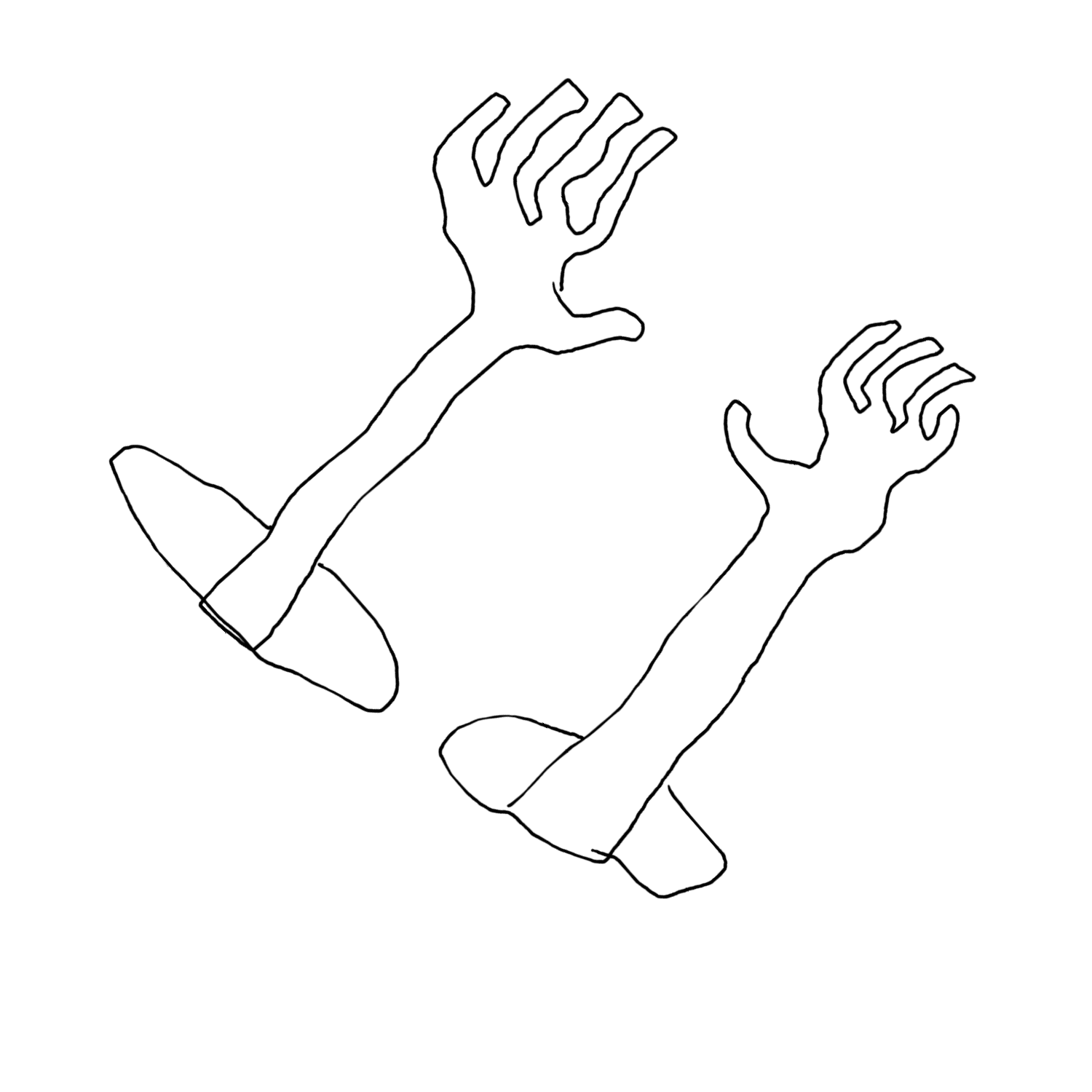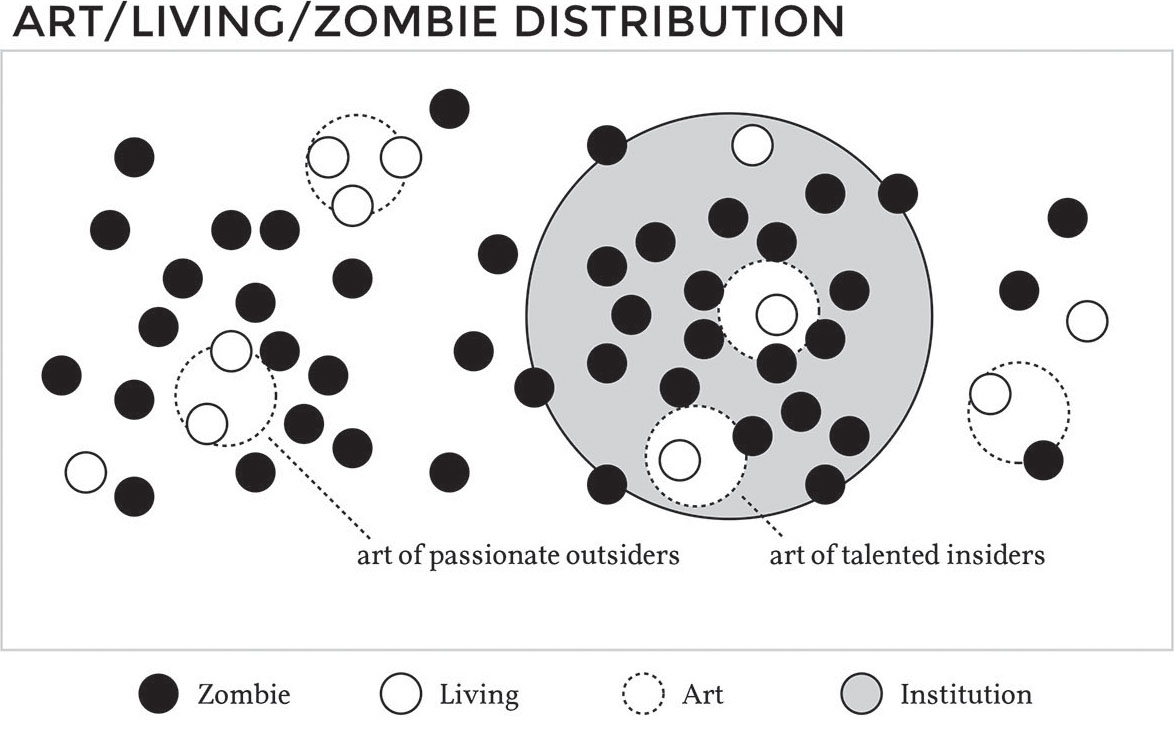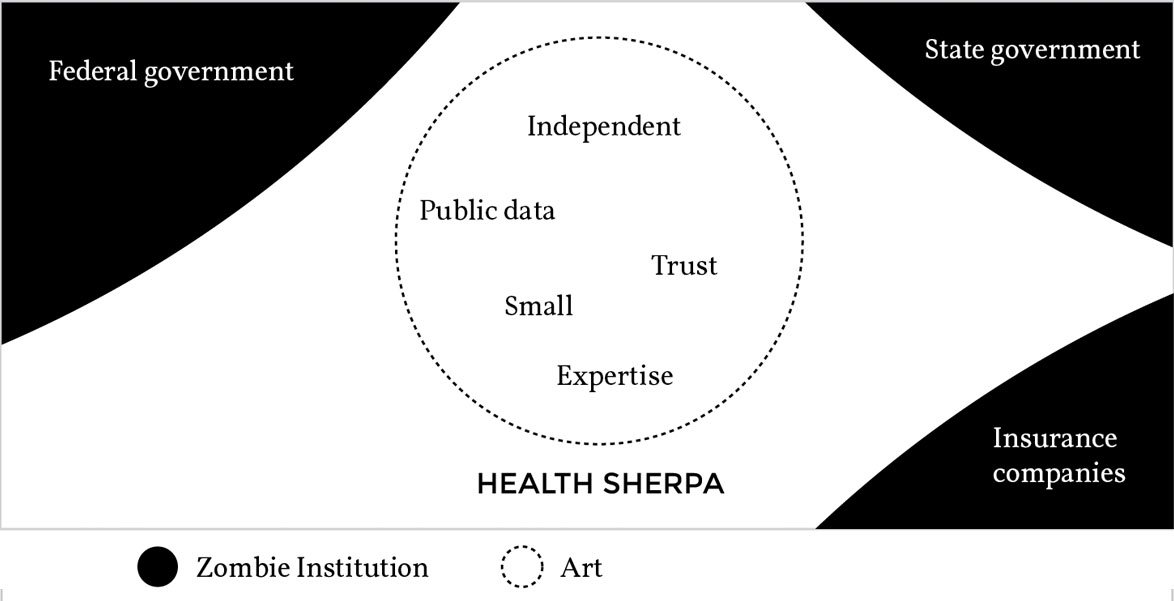Inside or Out
"Nobody's madder than me about the fact that the website isn't working as well as it should." — President Barack Obama

As an artist you will have one of two relationships with zombie institutions. You will either be on the outside trying to blaze a new path or on the inside hoping to bring about change from within. Insiders and outsiders both share a passion for their art and possess skills that allow them to advance their field, but they often fail because they can't overcome the crippling challenges inherent in challenging enormous zombie institutions.
Passionate outsiders fight for revolution, creating alternatives to the institutional products. Often they have the solution but lack the inertia to bring about change.
Insiders work from within the zombie system to produce good work, winning small victories one battle at a time. Often, they are incapable of turning the ship around.
If we were to map the distribution of zombies and artists in relationship to an institution it would look like the chart on the next page. The black circles are zombies, the white dots are artists. The large gray circle represents an institution. The dots within the institution's circle are insiders, and the dots on the outside represent outsiders. The dotted circles represent art. Not all artists create art. Zombies can't create art, so they are never inside a dotted circle. Small packets of artists are creating art despite being surrounded by zombies. Some of the artists are insiders creating art within an institution, while other artists are outsiders.

You can predict from this distribution map that it is going to be hard for the artists to protect their art. The zombies outnumber the artists and some are already swarming towards the art, attempting to destroy the dotted bubbles.
As we will learn, each type of artist, insider and outsider, faces unique challenges. To illustrate this we will study an infamous institution, America's healthcare system, specifically the creation of the website, healthcare.gov.
Passionate Outsiders: Health Sherpa
"We need to overhaul healthcare in America," is a good example of a spineless platitude. Talking about big problems in the world makes you sound noble, but it is usually just talk. The zombies feel safe knowing that because they are outsiders they will never have to actually work to backup their rhetoric. There are artists on the outside, however, who aren't content with just talking about the problem. They roll up their sleeves and work to make a meaningful difference.

The launch of the healthcare.gov website was a disaster. With estimates for the cost of the website somewhere in the $600 million range it is the most expensive website ever created. President Barack Obama admits that,
"Nobody's been more frustrated (than me). I wanted to go in and fix it myself, but I don't write code."
What would happen if a team of brilliant artists worked to fix the problem? What if these outsiders weren't working for a chunk of the $600 million, but because they were committed to doing meaningful work? The result would be something like thehealthsherpa.com.
 The front end design of healthcare.gov, created by Development Seed, never went online despite the disasterous launch
The front end design of healthcare.gov, created by Development Seed, never went online despite the disasterous launch
The Health Sherpa was created by three artists named George Kalogeropoulos, Ning Liang, and Michael Wasser. Their website, healthsherpa.com, allows you to compare policies and get quotes, a basic expectation which the government site couldn't do at the time of launch. While not a full blown replacement for healthcare.gov these artists were able to create a better user experience in three days for free than the government and a handful of contractors could with $600 million and much longer development time. The Health Sherpa website proudly boasts that it "is not affiliated with any lobby, trade group or government agency and has no political agenda." The Sherpa team creates art because they are passionate about helping people make better decisions through data.
Health Sherpa succeeded where the government failed because they were highly skilled, independently funded, and were motivated by their personal value system that emphasized responsibility, transparency, and independence. By aggregating publicly available data, they were able to bypass not only the federal government bureaucracy, but also the mine field of state government policies and the idiosyncracies of countless private insurance providers.
Unfortunately, the accomplishment of Health Sherpa, while amazing, can't be seen as anything more than a novel experiment because it failed to fundamentally change the zombie institutions. Ultimately there is only so much Health Sherpa can do as outsiders. They rely on public data, so when a zombie institution closes their system to outsiders there is little recourse. Not all insurance companies make their rates accessible to outsiders, which skews the data Health Sherpa presents. While you can compare rates on Health Sherpa's site, the actual sign up process remains behind the gates of each state's unique mandates. Connecting deeper into to the system, accessing IRS or DHS data for example, would be impossible for outsiders.
As an outsider, Health Sherpa is small, fast, and independent. Although they possess the exact skills needed to solve many of the problems that have crippled healthcare.gov, there is little hope that they will be able to bring about change as outsiders. Could the solution be found on the inside?
Skilled Insiders: Development Seed
 Every organization contains skilled insiders no matter how corrupt they may appear from the outside. It might not be visible to outsiders, but inside these zombie corporations are often skilled artists who are trying to make a difference. They are working at the source of the problem, directly applying their skills to the problems at hand. For these artists, the victories are small, the progress is slow, and the rewards aren't fame or fortune. They do meaningful work because they believe they can make a difference.
Every organization contains skilled insiders no matter how corrupt they may appear from the outside. It might not be visible to outsiders, but inside these zombie corporations are often skilled artists who are trying to make a difference. They are working at the source of the problem, directly applying their skills to the problems at hand. For these artists, the victories are small, the progress is slow, and the rewards aren't fame or fortune. They do meaningful work because they believe they can make a difference.
Insiders are a hard population to get information on because they are nearly invisible. They risk their careers if they speak publicly about the battles they are fighting.
Some of the first people to write code for healthcare.gov were a small team from a company called Development Seed who was hired to produce the website's front end. One of the key principles that guides Development Seed is a belief in open source software. That means they share their code freely and make no claims of copyright on their contributions. Open source software is transparent, constantly improving as a result of active contributors, and free from the death grip that comes with ownership complications and over-protective secrecy.
Development Seed made sure the code (at least the code that they were responsible for) was open source. They used GitHub, one of the main code sharing websites, to publish their healthcare.gov code. GitHub is more than just a place where you dump code. Any code on GitHub can be forked by any of GitHub's four million users, edited, and submitted for possible inclusion in the master branch. Code can be refined by anyone in the community and quickly patched and improved. It also keeps a running log of any and all changes made to the code base, meaning nobody can hide behind a smokescreen of anonymity. The fact that the healthcare website was going to be open source was applauded by developers everywhere.
The first phase of the healthcare website launched in June 2013 to great reviews. The ability to order insurance wasn't scheduled until October 1, but things were off to a good start. The Atlantic called the site "a huge win for the American people," sighting how unprecedented it was to have a government website created in public using open source tools. The site was praised because it didn't use Drupal or Percussion, the bloated content management systems that power most government websites. The site was praised because it incorporated an API that allowed other developers to embed content from the site. The site was praised for its simplicity, theoretically allowing administrators with basic computer skills to make updates, a task that usually requires expensive outside experts. It was fast, it was cheap, and it was open. It was going to change how governments build websites. It seemed like a dream come true.
About three months later, healthcare.gov would make headlines as thousands of users flocked to the site to sign up for healthcare. The website failed miserably. The reason for the disaster was that the critical functionality of the website wasn't created by artists like Development Seed, but by two zombie corporations called CGI Federal and Quality Software Services Inc. (QSSI). You can tell just from the names that these are not small teams of specialists, but giant zombie corporations that are great at absorbing millions of dollars but not great at creating functioning websites.
Why would the project get handed from Development Seed to CGI Federal and QSSI? The answer is that there are only sixteen companies qualified to provide certain tech services to the federal government. These contracts are awarded not by ability, but through a bureaucratic process. Development Seed wasn't on the list of ordained companies. The way to secure government work is not by being an expert in your field, but by greasing the wheels in Washington. CGI spends $200,000 lobbying and donates another $125,000 to campaign funds per year. Eric Gundersen, chief executive of Development Seed isn't interested in playing that game, and explains,
"We don't have proposal writers and lawyers. We have developers."
Despite the abomination that brought such well-deserved terrible press to healthcare.gov, the work done by Development Seed has remained online and functional. Every code change they submitted was made publicly with complete transparency. It is unknown how much money Development Seed received for their portion of the website but it was barely a fraction of the total $600 million total costs.
Development Seed has not been involved in healthcare.gov since CGI Federal and QSSI took over the project. Under strange circumstances, the GitHub repository was taken offline, essentially putting an iron curtain in front of the formerly transparent code. CGI Federal and QSSI don't share their code. They are not active members of the influential open source community. There is no public log of their code changes or breadcrumbs of code contributions. They just leach government money and deflect criticism because they are carefully setup so that nobody can directly be blamed.
If you look at the insider map you will see a white circle connected to Development Seed. This represents Bryan Sivak. He is the Chief Technology Officer at the Department of Health and Human Services and was the person responsible for hiring Development Seed. Eric Gundersen praised Sivak, lamenting the government failure saying,
"We've probably got one of the most visionary guys, that actually gets code, from a tech background, being the chief technology officer, and still he can't turn the battleship."
There isn't a happy ending for Health Sherpa or Development Seed. While both companies epitomize artistic contribution, the impact of their efforts is small. This is discouraging because most of us are fighting similar battles either as skilled insiders or passionate outsiders. Next we will take a look at another case study, zooming in even further, this time on another zombie institution, American Airlines.